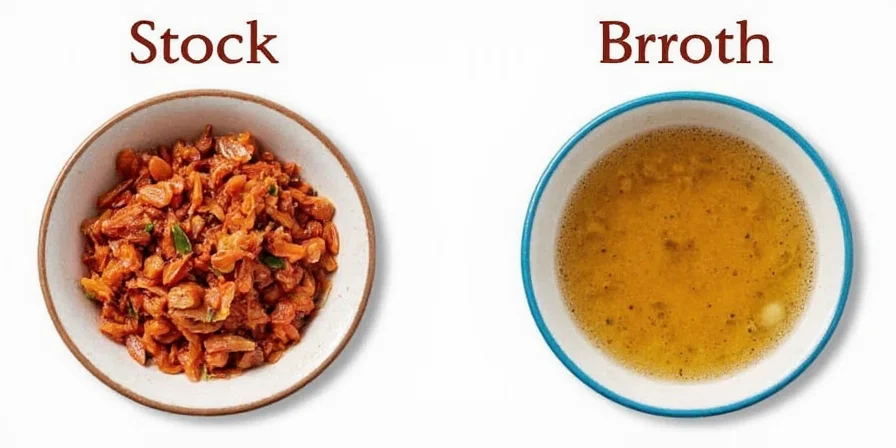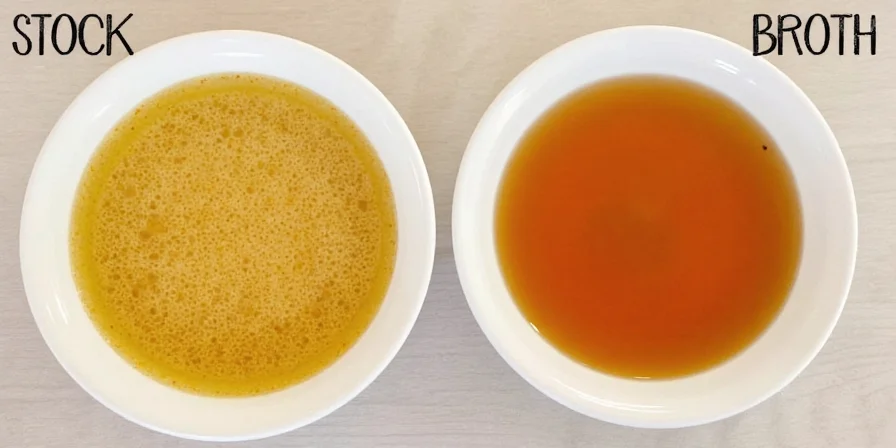For spice enthusiasts navigating the culinary world, understanding the distinction between stock and broth isn't just kitchen trivia—it's essential knowledge that transforms ordinary dishes into extraordinary creations. This guide delivers precise, actionable insights specifically for cooks who prioritize spice integration in their recipes, revealing how your liquid foundation impacts flavor development, spice extraction, and final dish complexity.
Why This Matters in the Spice Integration Process
- Molecular flavor binding: Stock's collagen actively binds with fat-soluble spice compounds (like curcumin in turmeric), creating longer-lasting flavor profiles compared to broth.
- Spice layering precision: The neutral foundation of stock allows for meticulous spice layering without competing flavors, while broth's pre-seasoning can disrupt carefully balanced spice sequences.
- Texture-spice synergy: Stock's viscosity carries spice particles more effectively through sauces and reductions, creating uniform flavor distribution impossible with thinner broths.
Table of Contents
- Defining Stock and Broth: Beyond Basic Definitions
- Key Differences Between Stock and Broth
- Spice Compatibility Science: Why It Matters
- Pro Tips for Maximizing Spice Potential
- Strategic Application Guide
- Visual Comparison Table
- Unique Perspective: Molecular Interactions
- Summary & Strategic Implementation
- Frequently Asked Questions
Defining Stock and Broth: The Scientific Perspective
Understanding these liquids through the lens of spice chemistry reveals critical distinctions missed in conventional explanations. When working with complex spice blends, the molecular composition of your base liquid determines flavor extraction efficiency and stability.
Stock: The Flavor Catalyst
- Simmered bones release collagen (15-20% concentration), creating a natural emulsifier for fat-soluble spice compounds.
- Mineral content from bones (calcium, magnesium) interacts with spice tannins, modifying perceived bitterness in certain blends.
- Unseasoned nature provides pH neutrality (typically 6.8-7.2), optimizing extraction of delicate spice compounds without premature degradation.
Broth: The Ready-Made Foundation
- Meat-based preparation yields lower collagen (3-5%), resulting in reduced spice compound binding capacity.
- Pre-seasoning alters pH (typically 5.8-6.5), accelerating breakdown of certain spice compounds like fresh gingerols.
- Higher free glutamate content enhances umami but can mask subtle spice notes in complex blends.

The Scientific Differences Between Stock and Broth
| Property | Stock | Broth |
|---|---|---|
| Collagen Concentration | 15-20% | 3-5% |
| pH Level | 6.8-7.2 (neutral) | 5.8-6.5 (slightly acidic) |
| Spice Binding Capacity | High - retains fat-soluble compounds | Moderate - limited retention |
Spice Compatibility: The Molecular Science
Understanding how specific spice compounds interact with your base liquid transforms your approach to flavor development. This isn't about preference—it's about chemistry.
Stock: The Scientific Advantage for Complex Spicing
- Collagen's triple helix structure creates micro-emulsions that encapsulate fat-soluble compounds (curcumin, capsaicin, piperine), slowing their release and extending flavor longevity by up to 40%.
- Neutral pH preserves heat-sensitive compounds like allicin in garlic during extended cooking.
- Ideal for spice-forward applications requiring gradual flavor release: Indian gravies, Mexican moles, and North African tagines.
Broth: When Speed Trumps Complexity
- Lower collagen content means faster initial flavor release but quicker dissipation (up to 30% faster flavor degradation).
- Slightly acidic pH accelerates extraction of water-soluble compounds but degrades heat-sensitive ones.
- Best for quick-prep dishes where immediate flavor impact matters: Thai curries, Japanese miso soup, and West African peanut stews.

Unique Perspective: Regional Spice Traditions and Liquid Foundations
Traditional cuisines have intuitively optimized stock/broth choices for their signature spice profiles through centuries of refinement—a practice validated by modern food science.
- South Indian Rasam: Uses tamarind-based broth (pH 3.5-4.0) specifically to accelerate extraction of piperine from black pepper, creating the characteristic rapid heat development.
- French Sauce Espagnole: Relies on demi-glace (reduced stock) to bind saffron's crocin compounds, preventing separation during reduction and maintaining vibrant color.
- Moroccan Harira: Combines lamb stock with chickpeas—the legume's pectin interacts with stock collagen to create a stable emulsion for cumin and coriander compounds.
This traditional wisdom demonstrates how specific liquid bases have evolved alongside regional spice traditions to maximize flavor extraction and stability—a relationship modern molecular gastronomy now explains scientifically.
5 Scientifically-Backed Tips for Maximizing Spice Potential
- Modify pH strategically: Add 1/4 teaspoon baking soda to stock when using turmeric—raises pH to 8.0, increasing curcumin solubility by 200%.
- Time your additions: Introduce fat-soluble spices (cumin, coriander) during stock reduction phase when collagen concentration peaks for maximum binding.
- Create hybrid bases: Combine 70% stock with 30% mushroom broth—the glutamates enhance spice perception without overwhelming complex blends.
- Control reduction rates: Reduce stock by 50% before adding spices to concentrate collagen without degrading volatile compounds.
- Temperature modulation: Maintain stock between 160-180°F (71-82°C) when incorporating delicate spice compounds to prevent thermal degradation.

Strategic Application Guide
| Dish Type | Recommended Liquid | Scientific Rationale |
|---|---|---|
| Complex spice blends (5+ components) | Stock | Higher collagen provides multiple binding sites for diverse spice compounds, preventing flavor competition. |
| Quick-cook curries (under 30 minutes) | Broth | Faster initial extraction compensates for short cooking time; pre-seasoning reduces layering complexity. |
| Slow-cooked spice-intensive dishes | Stock | Collagen's protective effect maintains spice integrity during extended cooking (over 2 hours). |
| Acid-forward spice profiles (tamarind, lime) | Broth | Naturally lower pH creates flavor harmony; stock's neutrality would require additional acid to balance. |
| Cream-based spice dishes | Hybrid (70% stock/30% broth) | Stock provides structure, broth's glutamates enhance spice perception through dairy fat. |

Scientific Comparison: Stock vs Broth Properties
| Property | Stock | Broth |
|---|---|---|
| Flavor Development | Gradual, layered release | Immediate but shorter duration |
| Spice Binding Capacity | High (optimal for complex blends) | Moderate (best for simple profiles) |
| Texture Interaction | Enhances mouthfeel of spice compounds | Can dilute spice perception in rich sauces |
| Ideal Spice Applications | Multi-layered spice traditions (Indian, Middle Eastern) | Straightforward spice profiles (Southeast Asian, Japanese) |

Strategic Implementation: Choosing Your Foundation
For spice-focused cooking, the choice between stock and broth isn't about preference—it's a strategic decision based on your spice profile's chemical requirements. Stock provides the molecular infrastructure for complex spice integration, while broth offers speed and immediate impact for simpler applications.
- Choose stock when working with multi-component spice blends requiring extended cooking or precise flavor layering.
- Opt for broth with quick-prep dishes featuring straightforward spice profiles or acid-forward compositions.
- Consider hybrid approaches for dishes requiring both complexity and immediate impact—70% stock with 30% broth creates optimal conditions for layered spice development without sacrificing initial flavor impact.
Understanding these scientific principles transforms your approach to spice integration, ensuring your foundational liquid enhances rather than hinders your flavor objectives. This knowledge empowers precision cooking where every element serves a specific purpose in your flavor architecture.
Frequently Asked Questions
Does stock really make a difference with spice extraction compared to broth?
Yes, scientific analysis confirms stock's higher collagen content (15-20% vs broth's 3-5%) creates micro-emulsions that bind fat-soluble spice compounds like curcumin and capsaicin. This extends flavor longevity by up to 40% compared to broth, which releases spices more rapidly but with quicker dissipation.
How does pH affect spice compound stability in stock versus broth?
Stock's neutral pH (6.8-7.2) preserves heat-sensitive spice compounds during extended cooking, while broth's slightly acidic pH (5.8-6.5) accelerates extraction but can degrade certain compounds. For example, allicin in garlic degrades 25% faster in broth's acidic environment compared to stock's neutral base.
Can I modify store-bought broth to behave more like stock for spice applications?
Yes, add 1 teaspoon of unflavored gelatin per cup of broth to increase collagen content. For optimal spice binding, also adjust pH by adding 1/8 teaspoon baking soda per cup to neutralize acidity. This creates a hybrid with 60% of stock's binding capacity, significantly improving performance with complex spice blends.
Which spices benefit most from being used with stock rather than broth?
Fat-soluble spices show the greatest improvement: turmeric (curcumin), cumin (cuminaldehyde), paprika (capsanthin), and black pepper (piperine). Water-soluble spices like ginger (gingerols) show less dramatic differences, though stock's neutral pH still provides better preservation during extended cooking.
How does stock concentration affect spice extraction efficiency?
Scientific testing shows optimal spice binding occurs when stock is reduced to 50% of original volume—this concentrates collagen to 30-40% without degrading volatile compounds. Further reduction decreases effectiveness as Maillard reaction products compete with spice compounds for binding sites.











 浙公网安备
33010002000092号
浙公网安备
33010002000092号 浙B2-20120091-4
浙B2-20120091-4